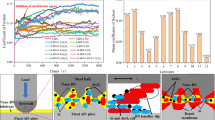Abstract
The lubrication performance of alumina (Al2O3) nanoparticle water-based suspensions was systematically investigated using a ball-on-three-plate testing configuration with alloy steel on stainless steel contact. The size and concentration of Al2O3 nanoparticle were varied to obtain optimal performance. The effects of testing load, sliding speed and contact surface roughness on the lubrication performance of the Al2O3 suspensions were investigated. It was found that 1 to 2 wt.% 30 nm Al2O3 nanoparticle suspensions showed up to 27% friction and 22% wear reduction, in comparison with water glycerol solution. Under different testing conditions, the suspensions also showed noticeably more stable and improved tribological performance. Wear mark analysis revealed that during tribological testing the nanoparticles formed a layer of dynamically balanced tribo-thin film, preventing the direct contact between asperities of alloy steel ball and stainless steel plate. The nanoparticles were also believed to fill up the trenches of the plate surface through mending effect and carry the wear debris induced in running-in period to avoid abrasive wear.














Similar content being viewed by others
References
Yoshizawa, H., Chen, Y.L., Israelachvili, J.: Fundamental mechanisms of interfacial friction 1. Relation between adhesion and friction. J. Phys. Chem. 97(16), 4128–4140 (1993)
Schmid, S.R., Wilson, W.R.D.: Lubrication mechanisms for oil-in-water emulsions. Lubr. Eng. 52(2), 168–175 (1996)
Gao, Y.J., Chen, G.X., Oli, Y., Zhang, Z.J., Xue, Q.J.: Study on tribological properties of oleic acid-modified TiO2 nanoparticle in water. Wear 252(5–6), 454–458 (2002)
Peng, Y.T., Hu, Y.Z., Wang, H.: Tribological behaviors of surfactant-functionalized carbon nanotubes as lubricant additive in water. Tribol. Lett. 25(3), 247–253 (2007)
Lei, H., Guan, W.C., Luo, J.B.: Tribological behavior of fullerene-styrene sulfonic acid copolymer as water-based lubricant additive. Wear 252(3–4), 345–350 (2002)
Bowden, F.P., Tabor, D.: Friction and Lubrication. Methuen, London (1960)
Tomala, A., Karpinska, A., Werner, W., Olver, A., Störi, H.: Tribological properties of additives for water-based lubricants. Wear 269(11), 804–810 (2010)
Cho, D.H., Kim, J.S., Kwon, S.H., Lee, C., Lee, Y.Z.: Evaluation of hexagonal boron nitride nano-sheets as a lubricant additive in water. Wear 302(1–2), 981–986 (2013)
Liu, Y.H., Wang, X.K., Pan, G.S., Luo, J.B.: A comparative study between graphene oxide and diamond nanoparticles as water-based lubricating additives. Sci. China Technol. Sci. 56(1), 152–157 (2013)
Padgurskas, J., Rukuiza, R., Prosycevas, I., Kreivaitis, R.: Tribological properties of lubricant additives of Fe, Cu and Co nanoparticles. Tribol. Int. 60, 224–232 (2013)
Wu, Y.Y., Tsui, W.C., Liu, T.C.: Experimental analysis of tribological properties of lubricating oils with nanoparticle additives. Wear 262(7–8), 819–825 (2007)
Gara, L., Zou, Q.: Friction and wear characteristics of water-based ZnO and Al2O3 nanofluids. Tribol. Trans. 55(3), 345–350 (2012)
Zhao, C.L., Chen, Y.K., Ren, G.: A study of tribological properties of water-based ceria nanofluids. Tribol. Trans. 56(2), 275–283 (2013)
Phuoc, T.X., Massoudi, M.: Experimental observations of the effects of shear rates and particle concentration on the viscosity of Fe2O3-deionized water nanofluids. Int. J. Therm. Sci. 48(7), 1294–1301 (2009)
Gu, Y., Zhao, X.C., Liu, Y., Lv, Y.X.: Preparation and tribological properties of dual-coated TiO2 nanoparticles as water-based lubricant additives. J. Nanomater. 2, 1–8 (2014)
Radice, S., Mischler, S.: Effect of electrochemical and mechanical parameters on the lubrication behaviour of Al2O3 nanoparticles in aqueous suspensions. Wear 261(9), 1032–1041 (2006)
Kato, H., Komai, K.: Tribofilm formation and mild wear by tribo-sintering of nanometer-sized oxide particles on rubbing steel surfaces. Wear 262(1–2), 36–41 (2007)
Murshed, S.M.S., Leong, K.C., Yang, C.: Enhanced thermal conductivity of TiO2-water based nanofluids. Int. J. Therm. Sci. 44(4), 367–373 (2005)
Mosleh, M., Atnafu, N.D., Belk, J.H., Nobles, O.M.: Modification of sheet metal forming fluids with dispersed nanoparticles for improved lubrication. Wear 267(5–8), 1220–1225 (2009)
Xu, J.G., Kato, K., Hirayama, T.: The transition of wear mode during the running-in process of silicon nitride sliding in water. Wear 205(1–2), 55–63 (1997)
Chen, M., Kato, K., Adachi, K.: The difference in running-in period and friction coefficient between self-mated Si3N4 and SiC under water lubrication. Tribol. Lett. 11(1), 23–28 (2001)
Lu, X., Khonsari, M., Gelinck, E.: The Stribeck curve: experimental results and theoretical prediction. J. Tribol. 128(4), 789–794 (2006)
Hersey, M.D.: Theory of lubrication. Wiley, New York (1938)
Novak, C., Kingman, D., Stern, K., Zou, Q., Gara, L.: Tribological properties of paraffinic oil with nanodiamond particles. Tribol. Trans. 57(5), 831–837 (2014)
Lee, K., Hwang, Y., Cheong, S., Choi, Y., Kwon, L., Lee, J., Kim, S.H.: Understanding the role of nanoparticles in nano-oil lubrication. Tribol. Lett. 35(2), 127–131 (2009)
Liu, G., Li, X., Qin, B., Xing, D., Guo, Y., Fan, R.: Investigation of the mending effect and mechanism of copper nano-particles on a tribologically stressed surface. Tribol. Lett. 17(4), 961–966 (2004)
Acknowledgements
The authors would like to acknowledge the financial supports from Baosteel under project BA13012 and Australia Research Council (ARC) through Linkage Project (LP150100591). This work was performed in part at the Queensland node of the Australian National Fabrication Facility (ANFF). ASH would like to acknowledge The University of Queensland (UQ) for the UQI Scholarship and the technical support and assistance from Dr. Heather Shewan. JRS acknowledges support from ARC Discovery Project DP150104147, and he acknowledges that the tribology-fixture used in this study is on loan from Anton Paar.
Author information
Authors and Affiliations
Corresponding author
Rights and permissions
About this article
Cite this article
He, A., Huang, S., Yun, JH. et al. Tribological Performance and Lubrication Mechanism of Alumina Nanoparticle Water-Based Suspensions in Ball-on-Three-Plate Testing. Tribol Lett 65, 40 (2017). https://doi.org/10.1007/s11249-017-0823-y
Received:
Accepted:
Published:
DOI: https://doi.org/10.1007/s11249-017-0823-y



